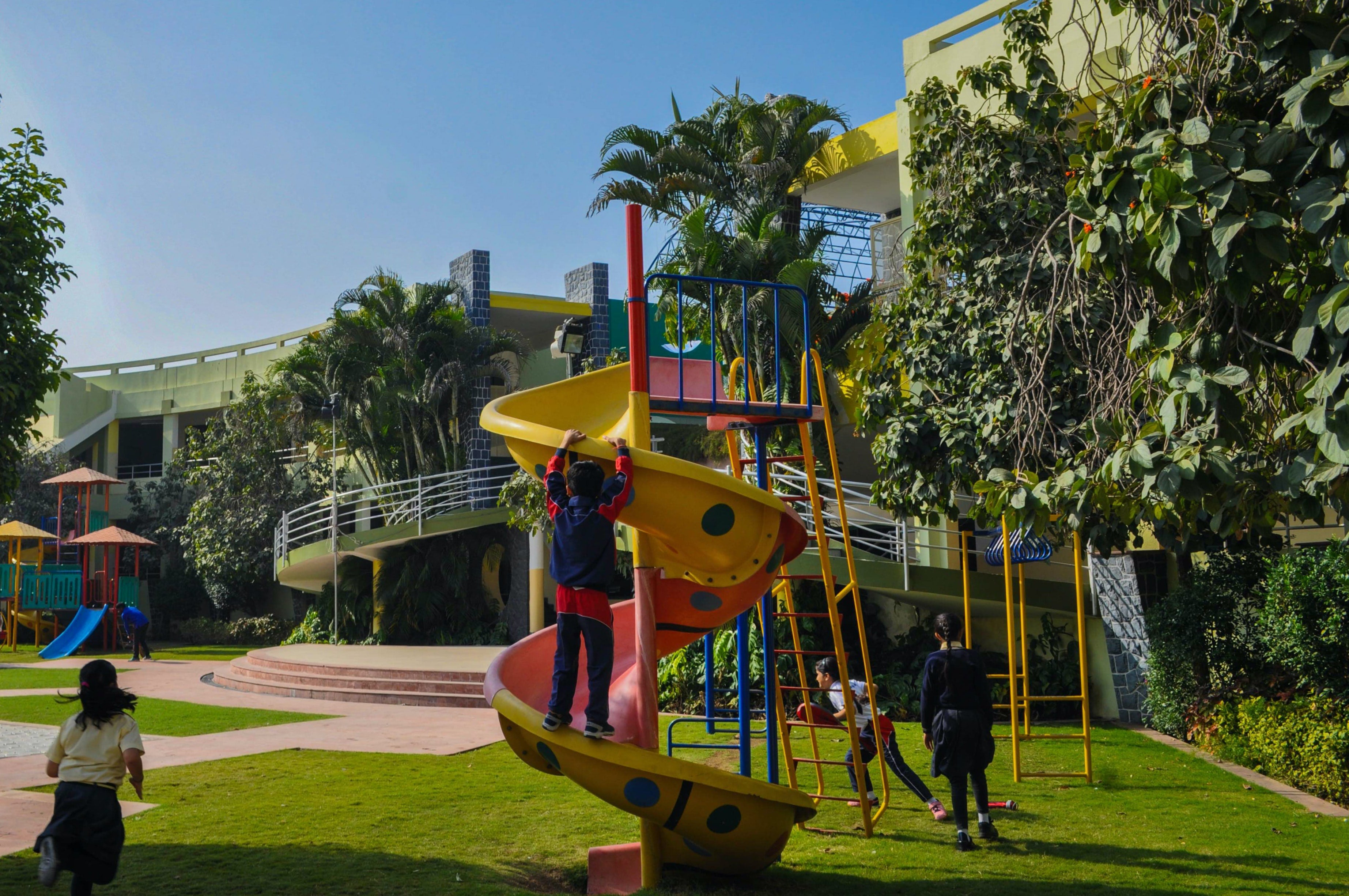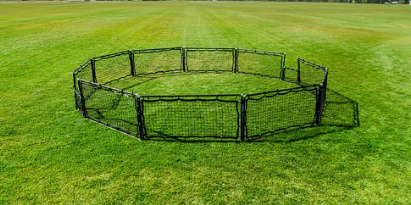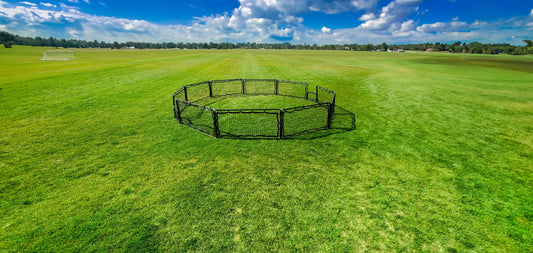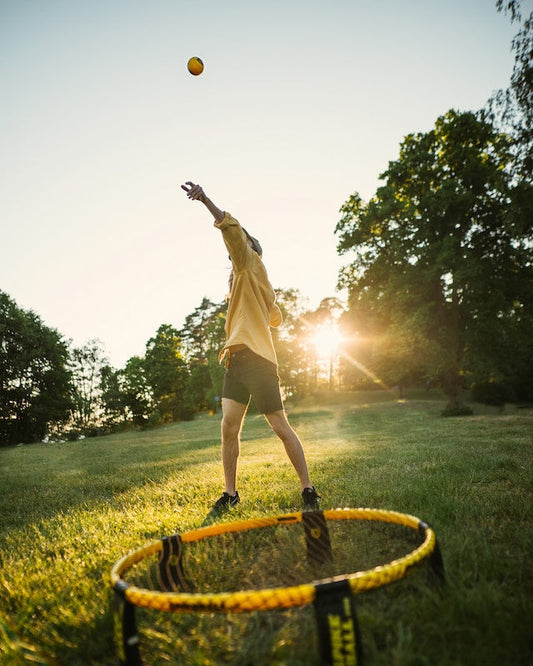Why Play Outdoors?
Outdoor play is crucial in a child's development, offering far-reaching benefits beyond physical health. According to Sanford Health, outdoor significantly contribute to a child's cognitive, social, emotional, and physical growth.
1. Improve Physical Strength
Indoor activities often lead to sedentary lifestyles, which are linked to obesity. Encouraging outdoor play can combat this, as studies show that children who play outside are more active, burning more calories and absorbing essential vitamin D from sunlight. This early engagement in outdoor games lays the foundation for stronger, healthier bodies.
2. Contribute to Cognitive, Social, and Emotional Development
Outdoor play sparks creativity and imagination. Children invent games and narratives, enhancing their cognitive abilities. This imaginative play, often in shared spaces, fosters social and emotional skills, teaching them about sharing, cooperation, and empathy.

3. Improved Sensory Skills
Playing outdoors exposes children to diverse sensory experiences. An optometry study highlighted that children who regularly play outside have better long-distance vision. Engaging with the natural world through all five senses enriches their understanding and appreciation of their environment.
4. Increased Attention Span
In contrast to the fleeting distractions of digital media, outdoor activities encourage sustained engagement. Studies, including those focusing on children with ADHD, have shown that time spent outdoors can extend attention spans and reduce hyperactivity.
5. Improved Mood and Immune System
Time outdoors is linked to enhanced mood and a stronger immune system. Exposure to natural light activates the pineal gland, boosting happiness and health. Happier children are often healthier, thanks in part to the immune-boosting effects of outdoor play.
Outdoor play is not just about physical activity; it's a comprehensive developmental tool. To help integrate outdoor play into children's lives, especially for those more accustomed to indoor activities, we've compiled a list of 30 engaging playground games and activities.
20 Best Playground Games for Kids
- Hide and Seek
One of the most entertaining games for kids is also the simplest. Hide and Seek is a classic outdoor activity that’s been around longer than anyone can remember. Additionally, almost all children know how to play the game with little instructions. To play Hide and Seek, choose one person to be the seeker. That person will cover their eyes and count to thirty (or any number). Once the timer is up, the seeker will uncover their eyes and look for those who are hiding. When they’ve all been found, the last person becomes the new seeker. Hide and Seek can entertain children for hours on end. When playing Hide and Seek, always have at least two adults who can watch where the kids are hiding. It’s also helpful to establish boundaries so that the kids don't wander too far away. When the kids are hiding, adults should make sure that they can always see where the kids are.

- Tag
Tag is another game that needs little to no explanation. Tag is one of the traditional games where the children race to catch up with one another and is a great way to get the kids running around. To play tag, choose one person to be “it.” That person will chase around the other kids on the playground until he or she tags someone. The child who is tagged becomes the new tagger. This is a great game to play around playground equipment because the kids can weave through the slides and ladders to get away from each other. Tag is a proven way to get out your kids’ energy. 
- Lava Monster
Lava Monster is a playground game that was created by kids for kids. The best place to play Lava Monster is on a playground because the playground equipment creates the perfect environment for the game. Lava Monster is a variation of tag, but the tagger is the only person allowed to walk on the ground. In this game, the kids pretend that the playground equipment floor is lava, meaning that they can’t walk on the ground without being burned. The lava monster lives in the lava and can’t go on the playground equipment, limiting the players.
The goal of the game is for the lava monster to tag the other plays. If the players aren’t moving, the lava monster can “freeze” the lava for ten seconds. During this time, the lava monster closes his or her eyes and counts to ten. The other players must move to the opposite side of the playground in ten seconds. While the lava is frozen, the players can walk on the ground, but they need to hurry because as soon as the lava thaws, they might get burned!

- Sidewalk Chalk Drawing
Although drawing with chalk isn’t an active game, it still encourages the kids to develop social skills as well as learn to appreciate art. To draw with chalk, all you will need is a bucket of chalk and a sidewalk or pavement area. Many parks, including your local school playground, will have an asphalt area perfect for sidewalk chalk. Let the kids have free reign of the chalk and encourage them to use their imagination as they draw different things. A child's imagination is limitless, and the kids will soon create their own games using the chalk, without any direction from the adults present. The kids might draw their own stores and pretend to sell flowers using chalk money. They might draw a castle and a dragon and pretend to live like royalty. Playing and drawing with chalk encourages children to grow and learn in a variety of ways.
Drawing with sidewalk chalk is a great option because both a young child and an older child will have the same amount of fun. Older children can sit down and draw with different colors, furthering developing vital art skills. Never underestimate the power of sidewalk chalk. 
- Hopscotch
Hopscotch is a traditional game that you can play at the playground. At some playgrounds, hopscotch may already be painted on the asphalt. However, for more creative games, bring chalk, and draw out new hopscotch courses. Each hopscotch tile should be numbered, which tells the kid where to place his or her feet next. The game involves constant jumping, helping the kids to move, jump, and run while playing outside. Show the kids how to draw their own hopscotch courses for additional creativity. Then, have each kid run through all the hopscotch courses.

- Capture the Flag
When you have access to a field next to the playground, Capture the Flag is a fun game for all ages. To play Capture the Flag, divide the group of kids into two teams. Each team will attach a flag to their waist that can be easily detached if the opposing team grabs the flag. Separate the field in half and place a flag at both ends. The flags represent the team’s home base. If the opposite team is able to grab the flag and take it across the line separating the two halves of the field, the team wins. To protect the flag, members of one team can grab the opposing team's flags when they cross over to the other team's field. If a player is tagged while on their opponent’s side, they must go to the holding zone, or “jail,” on their opponent’s side.
The game is a combination of defense and offense and requires that each team work together to both defend their flag and steal the other team’s flag. Some team members may also be sent to get their team members out of the opponent jail (which is done by tagging their team members inside the jail). Capture the Flag is a great way to get the kids moving. It is an incredibly active game, requiring the kids to run, jump, dodge, and grab. This game can help kids improve their coordination, agility, endurance, and speed.

- Four Square
A great game for both younger children and older children is Four Square. Four Square is a common game played during school recess hours. It’s simple, easy, and intuitive. To play, you will need four large squares drawn on the ground. One square is chosen as the “Queen” or “King” square. The Queen/King square decides which way the squares rotate. The players will take a spot inside their squares and then hit a rubber playground ball into another player’s square. That person will have to hit it back or to a different member of the game. If the ball goes out without bouncing in a different square, the player who hit the ball is out. The player is also out if the ball bounces more than once inside their square. Four Square helps kids to learn hand-eye coordination.
Another variation of the game Four Square is Nine Square. Nine Square puts a twist on the traditional game and makes the game more difficult, perfect for older children. Nine Square uses a three-by-three raised court, lifted above the player’s heads. Similar to Four Square, each child is confined to a specific square. Instead of hitting the ball on the ground, the players will hit the ball into the air, combining Four Square and Volleyball. This game helps children to think creatively about games and work to learn new skills.


- Spiderman Tag
Spiderman Tag is similar to Lava Monster in a lot of ways. However, in Spiderman Tag, the tagger closes his or her eyes. This means that the game is less active and more stealth. The players avoiding the tagger try to remain quiet, hoping that the tagger won't hear them and reach out to tag them. The players must stay on the equipment, but the tagger can walk on the ground or on the equipment. If a player touches the ground and the tagger hears it, the tagger can yell, "Fish out of water!" If the player is caught on the ground, they lose and become the new tagger. This game is better for older kids who can keep their balance while walking with their eyes closed.

- Treasure Hunt
Kids love using their imagination. They hear stories about hidden treasure and love the idea of having to look for something hidden to find a secret prize. Next time you’re taking your kids to the park, hide a secret treasure. Fill a box with candy or toys and then hide it somewhere in the park. If you’re filling the box with candy or treats, make sure that a responsible adult is watching over the hiding place to make sure that no one tampers with the treats while you’re with the children. Once the place is set up, create a map that leads to the hidden treasure. You can make it more interesting by hiding bits of the map so that each section of the map leads to the next section of the map. At the end of the map, the kids will find the hidden treasure. This is a great activity for little ones because it ignites their imagination. While playing the game, they will begin to believe that they are actively looking for real treasure, making them feel adventurous. This activity can also be done in a backyard.

- Gaga Ball
Gaga ball is extremely similar to dodgeball. Instead of splitting into two teams, it’s a battle royal. Typically, Gaga Ball is played in an arena or pit where the balls will bounce back into the center. However, it can be easily played in a grassy area or playground area for added obstacles. To play, put a pile of rubber balls (of all sizes) in the center of the playing area. At the end of a countdown, have all players race to grab a ball. Then, everyone will begin throwing the balls at one another. If a person is hit above the waist, the hit doesn’t count. However, any hits below the waist are fair game, and the person who was hit has to sit out. The game goes until only one person is standing.

- Monkey Bars
When playing on a playground, you have the option to simply let the kids play. Playgrounds have a variety of fun equipment that is perfect for entertaining kids. One popular option is the monkey bars. Monkey bars are a great option to entertain kids because they’re challenging. Kids who practice regularly on the monkey bars are often stronger physically and have more upper body strength. It also helps kids to learn hand to eye coordination. If your kid isn’t strong enough yet to play alone on the money bars, you can help by holding onto their waist and giving them a boost. This helps them to learn the right hand placement and slowly build up the needed muscle. Playing on the monkey bars is the perfect option for a stress-free day at your local park.

- Scavenger Hunt
Scavenger hunts are fun, exciting, and help kids to use up energy. Scavenger hunts can be played as a large group or with only a few kids. There are hundreds of variations that you can play. GoodHousekeeping has many options and ideas that will keep your kids entertained for hours. One great idea from the site is an art scavenger hunt: “Budding artists will appreciate the added element — drawing! — that makes this outdoor scavenger hunt unique. Plus, they’ll get to try their hand at creating everything from squirrels to flowers.” Be creative with your scavenger hunt ideas!

- Marbles
Many adults remember playing marbles when they were kids. Marbles is a simple game that continues to entertain children. The marbles themselves are fun to touch and play with, and the game can ensure that the kids are entertained with some adult supervision. If the kids playing are young enough to still put random objects in their mouths, you will need constant supervision over the marbles because the children may be tempted to swallow a few, which presents a choking hazard. When playing outside, all you need is a bag of marbles and a string or chalk to create a boundary. With your chalk, draw a circle on the ground and place ten marbles in the center. Then, kneel outside of the circle and flick your shooter marble into the circle. If you knock any marbles out of the circle, you get to keep them. Leave your shooting marble inside the circle with the other marbles and wait for your next turn. You will flick your marble on your next turn from its current location. The game continues until all marbles are knocked out of the circle.

- Obstacle Course
Setting up an obstacle course at a park is fairly easy, and you can get creative with what you chose to do. Obstacle courses are a way for kids to run and have fun without feeling like they’re being forced to exercise. The point of an obstacle course is to present various challenges and obstacles that the runners need to work their way around. For example, you might have a set of cones lined in a row, and the runners have to weave in and out of the cones. You could also set up chairs on the grass, and the runners have to crawl under the chairs. You can also set up a balance board that the players have to walk over to get to the next challenge. At the end of the course, set up a finish line so that the kids have something to work towards.

- Jump Rope
Jump rope is a fun way for kids of all ages to get their energy out. Both young children and older children will have fun playing jump rope at the park. You can have ropes of various sizes to accommodate different play styles. For example, some kids might prefer jumping with a large rope where two turners hold the rope's ends and turn the rope in unison. The person in the center jumps in and out while the others chant a rhyme. Some common jumping rope rhymes include:

The chants are sung as a rhyme, and when the jump roper trips or messes up their jump, the chant stops on the letter or number that the ground was counting to. The letter or number that ends the chant is the answer to the question. For example, if the jumper is jumping to the Ipsey Pipsey and the chant ends on the letter H, the answer will be a name starting in the letter H.
- Hula Hoop Race
A hula hoop race is a fun way to put a competitive edge on the classic game of hula hoop. Typically, the kids swing a hula hoop around their hips, building spinal flexibility and core strength. However, you can make this game into a race by having a starting point and ending point. The kids have to hula hoop from the starting line to the finish line. If the hula hoop falls, they have to start over.
Another fun way to use hula hoops is by using them as racing tools. Stand the hula hoop up on its side and push it. For a short distance, the hula hoop will roll forward. Roll the hula hoops from the starting line to the finish line.

- Geocaching
According to the official geocaching website, “Geocaching is a real-world, outdoor treasure hunting game using GPS-enabled devices. Participants navigate to a specific set of GPS coordinates and then attempt to find the geocache (container) hidden at that location.” Geocaches are hidden around the world, and their location is logged on the Geocache website. The geocaches are small boxes filled with tiny trinkets. Most are hidden along trails. When you find a geocache, you can take one item from the box as long as you put in another item. After finding a geocache, you must return it exactly how you found it. For a fun activity with your kids, look for geocaches in your area and embark on a real-life treasure hunt to find the geocache.

- Red Light, Green Light
The game Red Light, Green Light helps kids learn to listen closely to what the adult says. It’s an active but semi educational game. The game rules are extremely simple: when the leader says, “Green Light,” the kids run, and when the leader says, “Red Light,” the kids stop running. The goal is usually to get from a starting point to an ending point the fastest. To play at the park, set up a start line at the edge of the playground and a finish line at wherever you chose to stand. Then, yell, “Green Light!” and have all the kids run. They have to stop as soon as you say, “Red light.” If one of the kids continues to run after you say, “Red light,” the child has to sit out of the rest of the game. This is the perfect game for outdoor fun because it helps kids build endurance while also sculpting their listening skills.

- Red Rover
Red Rover is a popular game in elementary school. It involves teamwork and strength. To play, split the kids into two equal teams and line them up facing the opposite team. While standing in a line, have all the kids hold hands. The starting team will choose one player from the opposite team and chant, “Red rover, red rover, let [players name] come over.” The chosen player will run towards the team that called them and try to run through the linked hands. If the player can’t break through the link, the player is captured and joins hands with the new team. However, if the running player breaks through the link, he or she captures the two players from the opposite team who broke hands and brings them back to his or her original team. Rover Rover is best played on grassy areas where the kids have plenty of space to run.

- Freeze Dance
Playing a game like Freeze Dance is the perfect way to get kids out of their shells. Although the game can be played inside, bringing it outside gives the kids a chance to enjoy the sunlight. To play, put an adult in charge of the music. When the music is playing, all the kids start dancing; the crazier, the better. Get the adults involved as well and have them dance as crazy as possible, trying to make the kids laugh. When the music stops, everyone has to stop dancing. If someone moves at all once the music stops, they’re out of the game. Keep going until you have one dancer left.
Although having a structured game is always a great idea, sometimes it's okay to let the kids run on their own and use their imaginations. Kids will often make up games on their own, without any help or instruction from adults. The most important thing is that kids have a way to play safely while enjoying the outdoors.








